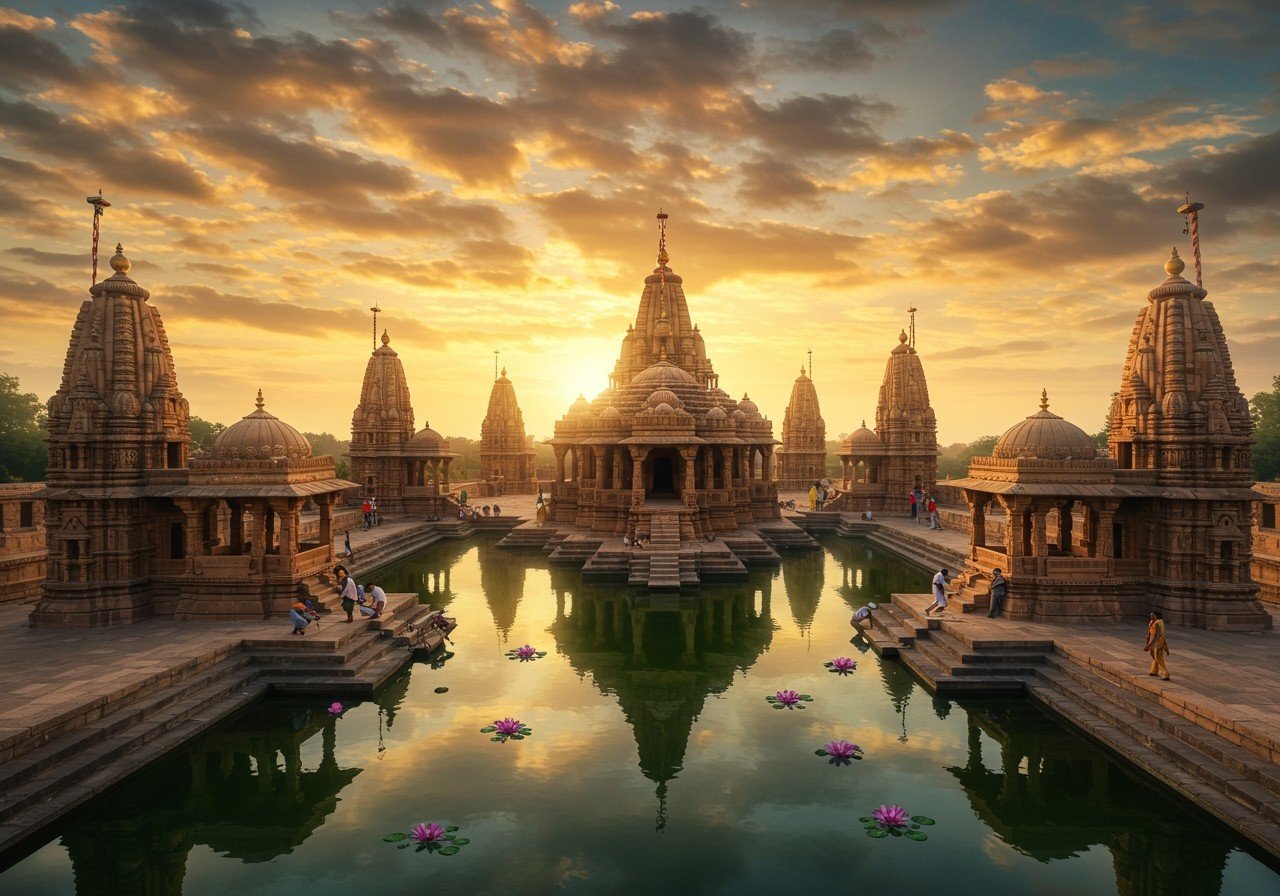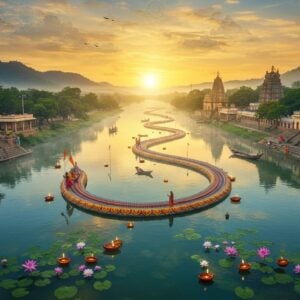
Embark on a spiritual journey to the Katas Raj Temples, a complex of ancient Hindu shrines nestled in the heart of Pakistan’s Potohar Plateau. More than just stones and carvings, these temples whisper tales of devotion, resilience, and the enduring power of faith. Join us as we explore their rich history, architectural marvels, and the ongoing efforts to preserve this sacred site for generations to come.
A Legacy Etched in Stone: The History of Katas Raj
The Katas Raj Temples boast a history as ancient as the land itself, with roots tracing back to prehistoric times. Architectural development flourished around the 7th century CE, under the patronage of the Hindu Shahi dynasties. Some believe the temples’ origins reach even further, to the legendary era of the Mahabharata, where the Pandava brothers are said to have sought refuge during their exile. This rich tapestry of history adds to the temples’ mystique and spiritual significance.
Central to the complex is the sacred pond, Katas, believed to have been formed by the tears of Lord Shiva mourning the loss of his beloved Sati. This poignant legend imbues the site with deep emotional resonance for devotees. The temples, dedicated to Lord Shiva, have drawn pilgrims for centuries, including revered figures like Guru Nanak, the founder of Sikhism, and the Sikh Emperor Ranjit Singh. The temples’ significance is further underscored by their mention in the travelogues of Faxian, a Chinese monk, and the historical accounts of British engineer Alexander Cunningham.
Architectural Wonders: A Glimpse into the Divine
The architecture of the Katas Raj Temples is a captivating blend of styles, reflecting the diverse influences that have shaped the region over centuries. Intricate carvings adorn the temple walls, depicting deities, mythological scenes, and intricate geometric patterns. The complex encompasses several shrines, each dedicated to a different deity, and the sacred pond is seamlessly integrated into the architectural design, creating a serene and spiritually charged atmosphere.
Stepping inside the temples, one is enveloped by a sense of reverence. The sanctum sanctorum, the garbha griha, houses the lingam and other sacred artifacts. The interplay of light and space within the temples enhances the spiritual ambiance, creating a space for contemplation and connection with the divine. The use of local materials in the construction adds to the authenticity and historical integrity of the structures.
Preservation and Renewal: Safeguarding a Sacred Legacy
The Katas Raj Temples, like many historical sites, have faced their share of challenges. Following the partition of India and Pakistan in 1947, the temples suffered a period of neglect. However, recent years have witnessed a renewed commitment to their preservation. The Pakistani government, along with various organizations, has initiated restoration projects, breathing new life into these ancient shrines.
One of the significant challenges has been the drying up of the sacred pond due to water usage by local industries. This environmental concern has prompted legal action and underscores the delicate balance between development and preservation. Ongoing efforts focus on addressing these challenges and ensuring the long-term sustainability of the site. The Evacuee Trust Property Board (ETPB) plays a crucial role in overseeing these initiatives, which include the construction of facilities for pilgrims and the implementation of environmentally friendly practices.
Enhance your spiritual journey with authentic puja items from poojn.in. We offer a wide selection of high-quality products for all your devotional needs.
Looking for items to enhance your personal sacred space or contribute to temple maintenance? poojn.in offers a curated collection:
- Holy Utensils: Discover pure copper and brass items for daily rituals, traditional puja thalis and kalash, durable temple bells, and elegant incense holders (Shop Now).
- Sacred Items for Worship: Find complete pooja samagri kits, pure cotton wicks, natural incense and dhoop, and traditional camphor and ghee (Explore our Collection).
- Temple Decoration: Adorn your sacred space with brass and copper décor, holy idols, traditional bells, and sacred symbols (Browse our Selection).
Poojn.in ensures quality, authenticity, and secure delivery across India. Contact us at 03369029784 or WhatsApp us at 9476142738.
A Shared Responsibility: Preserving Our Heritage
The Katas Raj Temples stand as a testament to the enduring power of faith and the rich cultural heritage of the region. Preserving these sacred spaces is not just a matter of historical preservation; it is an act of honoring the traditions and beliefs that have shaped generations. By supporting conservation efforts, promoting respectful tourism, and educating future generations about the significance of these sites, we can ensure that the legacy of Katas Raj continues to inspire and enlighten.
For those seeking to deepen their understanding of Lord Shiva and other deities, you might find our articles on Bhubaneswar’s Vishnu Temples and Yameshwar Temples in India enlightening. These explorations of sacred sites across India offer a broader perspective on Hindu traditions and temple architecture. They also highlight poojn.in’s dedication to the rich tapestry of Indian spirituality and heritage.
FAQs: Your Questions Answered
What is the architectural style of the Katas Raj Temples? The Katas Raj Temples showcase a blend of ancient Hindu architectural styles, evident in their intricate carvings and distinctive stone structures. This style reflects the rich history and cultural influences of the region.
Where are the Katas Raj Temples located? The temples are situated near Kallar Kahar Road in the Chakwal district of Punjab, Pakistan, making them accessible to visitors interested in exploring their historical and spiritual significance.
What is unique about the interior of the Katas Raj Temples? The interiors are adorned with beautifully carved idols and sculptures, with intricate designs on the walls and ceilings depicting Hindu deities and mythological stories. These artistic elements offer a glimpse into the spiritual and artistic heritage of the region.
How are the Katas Raj Temples being conserved? Ongoing conservation efforts focus on restoring the structures, preserving the artwork, and addressing environmental challenges. These projects aim to maintain the temples’ historical integrity while ensuring they remain accessible for future generations.
Why is it important to preserve the Katas Raj Temples? Preservation is crucial as these temples are an integral part of cultural and religious heritage. They serve as a testament to ancient architectural skills, religious practices, and historical events, holding significance for educational and spiritual purposes.
Can visitors access Katas Raj Temples year-round? Yes, visitors can generally access the temples throughout the year. However, it’s always advisable to check local guidelines or restrictions, especially during religious festivals or specific conservation activities.
Is there an entry fee for visiting the Katas Raj Temples? Typically, there isn’t an entry fee, though donations for the upkeep and conservation of the site are appreciated. Visitors are encouraged to contribute to these preservation efforts.
What should visitors know before visiting the Katas Raj Temples? Visitors should respect the sacred nature of the site by dressing modestly and adhering to any guidelines provided by the authorities. As a heritage site, it’s important to be mindful of preserving the environment and structures.


